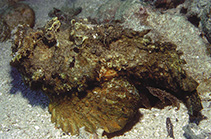
|
Synanceia horrida (Linnaeus, 1766) Estuarine stonefish |

|
|
photo by
Allen, G.R. |
| Family: | Synanceiidae (Stonefishes), subfamily: Synanceiinae | |||
| Max. size: | 60 cm TL (male/unsexed) | |||
| Environment: | reef-associated; brackish; marine; depth range 0 - 40 m | |||
| Distribution: | Indo-West Pacific: India to China, Philippines, Papua New Guinea and Australia. Reported from Vanuatu (Ref. 13300). | |||
| Diagnosis: | Dorsal spines (total): 13-14; Dorsal soft rays (total): 6-6; Anal spines: 3-3; Anal soft rays: 5-5. A drab species, usually brownish grey to reddish brown with a pattern of fine lines across the caudal fin. Eyes well elevated compared to the reef stonefish S. verrucosa (Ref. 48635). Description: Characterized by having dorsal spines almost equal in length, longest are second to fourth; large and fleshy pectoral fin; broad and depressed head; relatively small and widely separated eyes; dorsal mouth opening, vertical gape; fringe of cirri on lips; depth of body about 2.5 in SL (Ref. 90102). | |||
| Biology: | Inhabits coastal reefs and estuaries (Ref. 9710). Makes a shallow depression by scooping up sand or mud with its pectoral fins until it is piled up around the sides of its body. Lies motionless on sandy bottom areas. Comes out at night and often moves on top of reefs (Ref. 48635). In Guinness Book of Records as most venomous fish (Ref. 6472). Solitary in coral rubble and rocks, extremely difficult to detect (Ref 90102). | |||
| IUCN Red List Status: | Least Concern (LC); Date assessed: 20 June 2017 Ref. (130435) | |||
| Threat to humans: | venomous | |||